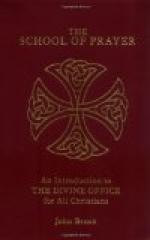The final stanza of a Breviary hymn is called the doxology ([Greek: doxa] praise, [Greek: logos] speech), a speaking of praise. Hymns which have the final stanza proper, the Ave Maris stella, Lauds hymn of the Blessed Sacrament, Matins hymn for several Martyrs, the first Vesper hymn of the Office of Holy Cross, and the Vesper hymns of St. Venantius and St. John Cantius, never change the wording of the stanza.
But, where the metre of the hymn admits such a change as possible in the last stanza.
(a) From Christmas to Epiphany Jesu tibi sit gloria, Qui natus es de Virgine is inserted in all hymns, even on saints’ offices.
(b) From Epiphany till end of its octave, Jesu tibi sit gloria, Qui apparuisti gentibus.
(c) From Low Sunday till Ascension Thursday, on Pentecost Sunday and its octave, all hymns end in Deo Patri sit gloria, Et Filio qui a mortuis.
This is the ending for all hymns of saints’ feasts in Paschal times, excepting those hymns mentioned above.
(d) From Ascension to Pentecost (except in the hymn Salutis humanae Sator) the doxology is Jesu tibi sit gloria, Qui victor in coelum redis.
(e) Feast of Transfiguration has Jesu, tibi sit gloria, Qui te revelas parvulis.
In all other hymns the doxology is read as it is printed in the Breviary.
Antiphons. Antiphon, coming from Greek words meaning a re-echoing of the sound, is a chant performed alternately by two choirs, and was used in pagan drama, long before the Christian era. At what date it was introduced into Church liturgy it is difficult to determine. Some say it was introduced by St. Ignatius, second Bishop of Antioch. It is certain that it was used by bishops and priests to attract, retain and teach the faithful during the Arian heresy. In church music, the lector ceased to recite the psalm as a solo and the faithful divided into two choirs, united in the refrain Gloria Patri.
With us, the antiphon generally is a verse or verses from Scripture, recited before and after each psalm. “The verse which serves as the antiphon text contains the fundamental thought of the psalm to which it is sung and indicates the point of view from which it is to be understood. In other words, it gives the key to the liturgical and mystical meaning of the psalm, with regard to the feast on which it occurs” (Cath. Encycl., art. “Antiphon").
Psalms. In the Breviary, before the recent reform, twelve psalms were recited in the first nocturn of Sundays and on ferias. This recitation of twelve psalms was, Cassian tells us, caused by the apparition of an angel, who appeared to the monks and sang at one session twelve psalms, terminating with Alleluia. The event was mentioned at the Council of Tours, In the new reform, nine psalms are recited at Matins; they should, the old writers on liturgy tell us, remind us of the nine choirs of angels who without ceasing sing God’s praise.




